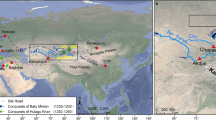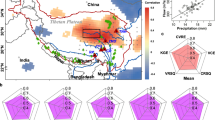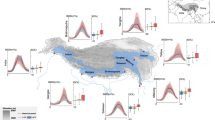Abstract
The great river systems originating from the Tibetan Plateau are pivotal for the wellbeing of more than half the global population. Our understanding of historical ranges and future changes in water availability for much of Southeast Asia is, however, limited by short observational records and complex environmental factors. Here we present annually resolved and absolutely dated tree ring-based streamflow reconstructions for the Mekong, Salween and Yarlung Tsangpo rivers since 1000 ce, which are supplemented by corresponding model projections until 2100 ce. We show a significant positive correlation between streamflow and dry season vegetation indices over the Indochinese Peninsula, revealing the importance of the Tibetan Water Tower for the functioning and productivity of ecological and societal systems in Southeast Asia. The streamflow variability is associated with low-frequency sea-surface temperature variability in the North Atlantic and North Pacific. We find that streamflow extremes coincide with distinct shifts in local populations that occurred during medieval times, including the occupation and subsequent collapse of Angkor Wat from the eleventh to the sixteenth century. Finally, our projections suggest that future streamflow changes will reach, or even exceed, historical ranges by the end of this century, posing unprecedented risks for Southeast Asia.
This is a preview of subscription content, access via your institution
Access options
Access Nature and 54 other Nature Portfolio journals
Get Nature+, our best-value online-access subscription
$29.99 / 30 days
cancel any time
Subscribe to this journal
Receive 12 print issues and online access
$259.00 per year
only $21.58 per issue
Buy this article
- Purchase on Springer Link
- Instant access to full article PDF
Prices may be subject to local taxes which are calculated during checkout




Similar content being viewed by others
Data availability
The streamflow reconstruction is downloaded from the Mendeley Data Repository Center (https://doi.org/10.17632/7km7vmk4f3.1). Palaeoclimate records for comparison in Fig. 2 were obtained from the National Centers for Environmental Information (https://www.ncei.noaa.gov/access/paleo-search/?dataTypeId=18). The CESM model data can be downloaded at https://www.earthsystemgrid.org/dataset/ucar.cgd.ccsm4.CESM_CAM5_LME.html, and the CMIP data can be downloaded at https://esgf-node.llnl.gov/search/cmip6/.
Code availability
The code to carry out the current analyses is available from the corresponding authors upon request.
References
Milly, P. C., Dunne, K. A. & Vecchia, A. V. Global pattern of trends in streamflow and water availability in a changing climate. Nature 438, 347–350 (2005).
Yao, T. et al. Recent Third Pole’s rapid warming accompanies cryospheric melt and water cycle intensification and interactions between monsoon and environment: multidisciplinary approach with observations, modeling, and analysis. Bull. Am. Meteorol. Soc. 100, 423–444 (2019).
Brun, F., Berthier, E., Wagnon, P., Kääb, A. & Treichler, D. A spatially resolved estimate of High Mountain Asia glacier mass balances from 2000 to 2016. Nat. Geosci. 10, 668–673 (2017).
Dehecq, A. et al. Twenty-first century glacier slowdown driven by mass loss in High Mountain Asia. Nat. Geosci. 12, 22–27 (2019).
Immerzeel, W. W., Van Beek, L. P. & Bierkens, M. F. Climate change will affect the Asian water towers. Science 328, 1382–1385 (2010).
Kraaijenbrink, P. D. A., Bierkens, M. F. P., Lutz, A. F. & Immerzeel, W. W. Impact of a global temperature rise of 1.5 degrees Celsius on Asia’s glaciers. Nature 549, 257–260 (2017).
Bolch, T. Hydrology: Asian glaciers are a reliable water source. Nature 545, 161–162 (2017).
Lutz, A. F., Immerzeel, W. W., Shrestha, A. B. & Bierkens, M. F. P. Consistent increase in High Asia’s runoff due to increasing glacier melt and precipitation. Nat. Clim. Change 4, 587–592 (2014).
Chellaney, B. Water: Asia’s New Battleground (Georgetown Univ. Press, 2011).
Liang, Y., Chen, Y., Chen, F. & Zhang, H. Possible role of the regional NDVI in the expansion of the Chiefdom of Lijiang during the Ming Dynasty as reflected by historical documents and tree rings. Weather Clim. Soc. 14, 1107–1118 (2022).
Wang, T. et al. Atmospheric dynamic constraints on Tibetan Plateau freshwater under Paris climate targets. Nat. Clim. Change 11, 219–225 (2021).
Lieberman, V. & Buckley, B. The impact of climate on Southeast Asia, circa 950–1820: New findings. Mod. Asian Stud. 46, 1049–1096 (2012).
Buckley, B. M., Fletcher, R., Wang, S. Y. S., Zottoli, B. & Pottier, C. Monsoon extremes and society over the past millennium on mainland Southeast Asia. Quat. Sci. Rev. 95, 1–19 (2014).
Day, M. B. et al. Paleoenvironmental history of the west Baray, Angkor (Cambodia). Proc. Natl Acad. Sci. USA 109, 1046–1051 (2012).
Fletcher, R., Buckley, B. M., Pottier, C. & Wang, S. Y. S. in Megadrought and Collapse: From Early Agriculture to Angkor (ed. Weiss, H.) 275–314 (2017).
Cook, E. R. et al. Asian monsoon failure and megadrought during the last millennium. Science 328, 486–489 (2010).
Buckley, B. M. et al. Climate as a contributing factor in the demise of Angkor, Cambodia. Proc. Natl Acad. Sci. USA 107, 6748–6752 (2010).
Chen, F. et al. Ecological and societal effects of Central Asian streamflow variation over the past eight centuries. NPJ Clim. Atmos. Sci. 5, 1–8 (2022).
DeMenocal, P. B. Cultural responses to climate change during the late Holocene. Science 292, 667–673 (2001).
Lieberman, V. Charter state collapse in Southeast Asia, ca. 1250–1400, as a problem in regional and world history. Am. Hist. Rev. 116, 937–963 (2011).
Fox, J. & Ledgerwood, J. Dry-season flood-recession rice in the Mekong Delta: two thousand years of sustainable agriculture? Asian Perspect. 38, 37–50 (1999).
Grill, G. et al. Mapping the world’s free-flowing rivers. Nature 569, 215–221 (2019).
Gao, J., Yao, T., Masson-Delmotte, V., Steen-Larsen, H. C. & Wang, W. Collapsing glaciers threaten Asia’s water supplies. Nature 565, 19–21 (2019).
Schmitt, R. J., Bizzi, S., Castelletti, A., Opperman, J. J. & Kondolf, G. M. Planning dam portfolios for low sediment trapping shows limits for sustainable hydropower in the Mekong. Sci. Adv. 5, eaaw2175 (2019).
Sabo, J. L. et al. Designing river flows to improve food security futures in the Lower Mekong Basin. Science 358, eaao1053 (2017).
Fendorf, S., Michael, H. A. & van Geen, A. Spatial and temporal variations of groundwater arsenic in South and Southeast Asia. Science 328, 1123–1127 (2010).
Hackney, C. R. River bank instability from unsustainable sand mining in the lower Mekong River. Nat. Sustain. 3, 1–9 (2020).
Pritchard, H. D. Asia’s shrinking glaciers protect large populations from drought stress. Nature 569, 649–654 (2019).
Veldkamp, T. I. E. et al. Water scarcity hotspots travel downstream due to human interventions in the 20th and 21st century. Nat. Commun. 8, 1–12 (2017).
Mekonnen, M. M. & Hoekstra, A. Y. Four billion people facing severe water scarcity. Sci. Adv. 2, e1500323 (2016).
Qi, W., Liu, J., Xia, J. & Chen, D. Divergent sensitivity of surface water and energy variables to precipitation product uncertainty in the Tibetan Plateau. J. Hydrol. 581, 124338 (2020).
Liu, W. et al. Investigating water budget dynamics in 18 river basins across the Tibetan Plateau through multiple datasets. Hydrol. Earth Syst. Sci. 22, 351–371 (2018).
Cook, E. R. et al. Five centuries of Upper Indus River flow from tree rings. J. Hydrol. 486, 365–375 (2013).
Chen, F. et al. 500-Year tree-ring reconstruction of Salween River streamflow related to the history of water supply in Southeast Asia. Clim. Dyn. 53, 6595–6607 (2019).
Nguyen, H. T., Turner, S. W., Buckley, B. M. & Galelli, S. Coherent streamflow variability in monsoon Asia over the past eight centuries-Links to oceanic drivers. Water Resour. Res. 56, e2020WR027883 (2020).
Rao, M. P. et al. Seven centuries of reconstructed Brahmaputra River discharge demonstrate underestimated high discharge and flood hazard frequency. Nat. Commun. 11, 1–10 (2020).
Wu, Y. et al. Reconstructed eight-century streamflow in the Tibetan Plateau reveals contrasting regional variability and strong nonstationarity. Nat. Commun. 13, 1–13 (2022).
Otto-Bliesner, B. L. et al. Climate variability and change since 850 CE: an ensemble approach with the Community Earth System Model. Bull. Am. Meteorol. Soc. 97, 735–754 (2016).
Harris, I., Osborn, T. J., Jones, P. & Lister, D. Version 4 of the CRU TS monthly high-resolution gridded multivariate climate dataset. Sci. Data 7, 1–18 (2020).
Ghiggi, G., Humphrey, V., Seneviratne, S. I. & Gudmundsson, L. G-RUN ENSEMBLE: a multi-forcing observation-based global runoff reanalysis. Water Resour. Res. 57, e2020WR028787 (2021).
Wang, J., Yang, B. & Ljungqvist, F. C. Moisture and temperature covariability over the Southeastern Tibetan Plateau during the Past Nine Centuries. J. Clim. 33, 6583–6598 (2020).
Treydte, K. S. et al. The twentieth century was the wettest period in northern Pakistan over the past millennium. Nature 440, 1179–1182 (2006).
Zhang, P. et al. A test of climate, sun, and culture relationships from an 1810-year Chinese cave record. Science 322, 940–942 (2008).
Thompson, L. G. et al. A high-resolution millennial record of the South Asian monsoon from Himalayan ice cores. Science 289, 1916–1919 (2000).
Vermote, E. & NOAA CDR Program. NOAA Climate Data Record (CDR) of AVHRR Normalized Difference Vegetation Index (NDVI), Version 5. NOAA https://doi.org/10.7289/V5ZG6QH9 (2019).
Rayner, N. A. A. et al. Global analyses of sea surface temperature, sea ice, and night marine air temperature since the late nineteenth century. J. Geophys. Res. Atmos. 108, D14 (2003).
Wang, J. et al. Internal and external forcing of multidecadal Atlantic climate variability over the past 1,200 years. Nat. Geosci. 10, 512–517 (2017).
Henley, B. J. et al. A tripole index for the interdecadal Pacific oscillation. Clim. Dyn. 45, 3077–3090 (2015).
MacDonald, G. M. & Case, R. A. Variations in the Pacific Decadal Oscillation over the past millennium. Geophys. Res. Lett. 32, L08703 (2005).
Wang, J., Yang, B. & Ljungqvist, F. C. A millennial summer temperature reconstruction for the eastern Tibetan Plateau from tree-ring width. J. Clim. 28, 5289–5304 (2015).
Yang, K. et al. Recent climate changes over the Tibetan Plateau and their impacts on energy and water cycle: a review. Glob. Planet. Change 112, 79–91 (2014).
Tan, L. et al. Rainfall variations in central Indo-Pacific over the past 2,700 y. Proc. Natl Acad. Sci. USA 116, 17201–17206 (2019).
Turner, A. G. & Annamalai, H. Climate change and the South Asian summer monsoon. Nat. Clim. Change 2, 587–595 (2012).
Kraaijenbrink, P. D., Stigter, E. E., Yao, T. & Immerzeel, W. W. Climate change decisive for Asia’s snow meltwater supply. Nat. Clim. Change 11, 591–597 (2021).
Fan, H. & He, D. Temperature and precipitation variability and its effects on streamflow in the upstream regions of the Lancang-Mekong and Nu-Salween Rivers. J. Hydrometeorol. 16, 2248–2263 (2015).
Cotterell, A. A History of South-East Asia (Marshall Cavendish International, 2014).
Hall, D. G. E. History of South East Asia (Macmillan International Higher Education, 1981).
Wolters, O. History, Culture and Region in Southeast Asian Perspectives (Cornell Univ. Press, 1999).
Aung-Thwin, M. & Aung-Thwin, M. A History of Myanmar Since Ancient Times: Traditions and Transformations (Reaktion Books, 2013).
Baran, E., Van Zalinge, N. & Bun, N. P. Floods, floodplains and fish production in the Mekong Basin: present and past trends. In Proc. Second Asian Wetlands Symposium, 27–30 August 2001, Penang, Malaysia pp. 920–932 (Penerbit Universiti Sains Malaysia, 2001).
Gundersen, L. G. A reassessment of the decline of the Khmer Empire. Int. J. Cult. Hist. 1, 63–66 (2015).
Carter, A. K. et al. Temple occupation and the tempo of collapse at Angkor Wat, Cambodia. Proc. Natl Acad. Sci. USA 116, 12226–12231 (2019).
Penny, D. & Beach, T. P. Historical socioecological transformations in the global tropics as an Anthropocene analogue. Proc. Natl Acad. Sci. USA 118, e2022211118 (2021).
Penny, D. et al. The demise of Angkor: systemic vulnerability of urban infrastructure to climatic variations. Sci. Adv. 4, eaau4029 (2018).
Bibi, S. et al. Climatic and associated cryospheric, biospheric, and hydrological changes on the Tibetan Plateau: a review. Int. J. Climatol. 38, 1–17 (2018).
Wang, J. et al. Tree-ring inferred annual mean temperature variations on the southeastern Tibetan Plateau during the last millennium and their relationships with the Atlantic Multidecadal Oscillation. Clim. Dyn. 43, 627–640 (2014).
Chen, F. et al. Late twentieth century rapid increase in high Asian seasonal snow and glacier-derived streamflow tracked by tree rings of the upper Indus River basin. Environ. Res. Lett. 16, 094055 (2021).
Meko, D. Dendroclimatic reconstruction with time varying predictor subsets of tree indices. J. Clim. 10, 687–696 (1997).
Fritts, H. C. Tree Rings and Climate (Academic Press, 1976).
Zhou, J. & Tung, K. K. Deducing multidecadal anthropogenic global warming trends using multiple regression analysis. J. Atmos. Sci. 70, 3–8 (2013).
Wang, J. et al. Causes of East Asian temperature multidecadal variability since 850 ce. Geophys. Res. Lett. 45, 13–485 (2018).
Mantua, N. J., Hare, S. R., Zhang, Y., Wallace, J. M. & Francis, R. C. A Pacific interdecadal climate oscillation with impacts on salmon production. Bull. Am. Meteorol. Soc. 78, 1069–1080 (1997).
Huang, X. et al. South Asian summer monsoon projections constrained by the interdecadal Pacific oscillation. Sci. Adv. 6, eaay6546 (2020).
Kay, J. et al. The Community Earth System Model (CESM) Large Ensemble Project: a community resource for studying climate change in the presence of internal climate variability. Bull. Am. Meteorol. Soc. 96, 1333e1349 (2015).
Huang, W. et al. Changes of climate regimes during the last millennium and the twenty-first century simulated by the Community Earth System Model. Quat. Sci. Rev. 180, 42–56 (2018).
Hessl, A. E. et al. Past and future drought in Mongolia. Sci. Adv. 4, e1701832 (2018).
Dai, A., Rasmussen, R. M., Ikeda, K. & Liu, C. A new approach to construct representative future forcing data for dynamic downscaling. Clim. Dyn. 55, 315–323 (2020).
Acknowledgements
This work was supported by Basic Science Center for Tibetan Plateau Earth System (BSCTPES, NSFC project no. 41988101), the 2nd Scientific Expedition to the Qinghai-Tibet Plateau (2019QZKK010206), NSFC (91547115, 42261144687, 42075041) and Jiangsu Collaborative Innovation Center for Climate Change. J.E. and U.B. acknowledge the support of the ERC Advanced project entitled Monostar (AdG 882727).
Author information
Authors and Affiliations
Contributions
F.C., D.H. and F.H.C. conceived and designed the study, with input from all other authors. F.C. and W.M. wrote the original drafts. F.C., W.M., S.W., X.Z. and M.H. performed analyses and generated all figures. All authors contributed to the discussions, reviews and improvement of this paper.
Corresponding authors
Ethics declarations
Competing interests
The authors declare no competing interests.
Peer review
Peer review information
Nature Geoscience thanks Jianglin Wang, Matthew Therrell and the other, anonymous, reviewer(s) for their contribution to the peer review of this work. Tom Richardson, in collaboration with the Nature Geoscience team.
Additional information
Publisher’s note Springer Nature remains neutral with regard to jurisdictional claims in published maps and institutional affiliations.
Supplementary information
Supplementary Information
Supplementary information.
Rights and permissions
Springer Nature or its licensor (e.g. a society or other partner) holds exclusive rights to this article under a publishing agreement with the author(s) or other rightsholder(s); author self-archiving of the accepted manuscript version of this article is solely governed by the terms of such publishing agreement and applicable law.
About this article
Cite this article
Chen, F., Man, W., Wang, S. et al. Southeast Asian ecological dependency on Tibetan Plateau streamflow over the last millennium. Nat. Geosci. 16, 1151–1158 (2023). https://doi.org/10.1038/s41561-023-01320-1
Received:
Accepted:
Published:
Issue Date:
DOI: https://doi.org/10.1038/s41561-023-01320-1
This article is cited by
-
Decreasing productivity of pine forests on the southern edge of the Mongolian Plateau as indicated by tree rings
Journal of Forestry Research (2024)



